Corsair RM750x PSU Review
Corsair released its RMx PSU line, which the company claims will offer good performance along with silent operation. Unlike the RMi models, the RMx units lack a digital interface, a fan test button, and uses a Rifle bearing fan instead of an FDB version.
Why you can trust Tom's Hardware
Efficiency, Temperature, Noise, Cross-Load Tests And Infrared Images
Efficiency
Our efficiency testing procedure is detailed here.
Using the results from the previous page, we plotted a chart showing the efficiency of the RM750x at low loads, and loads from 10 to 110 percent of the PSU's maximum-rated capacity.
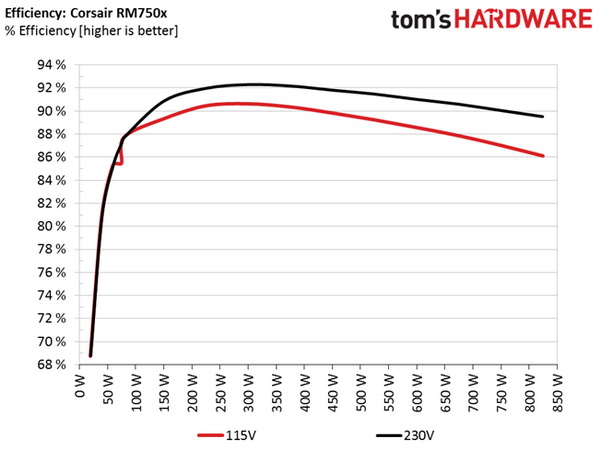
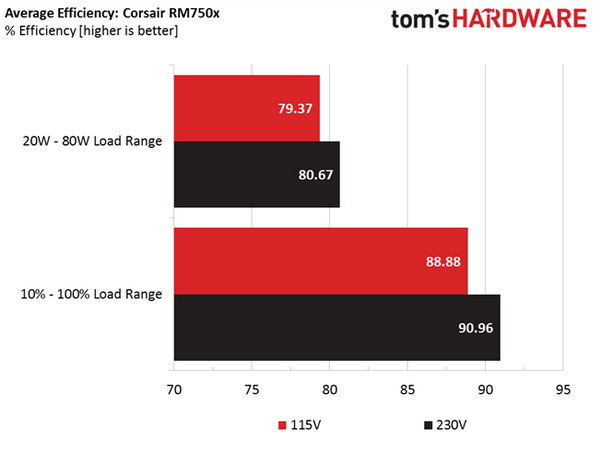
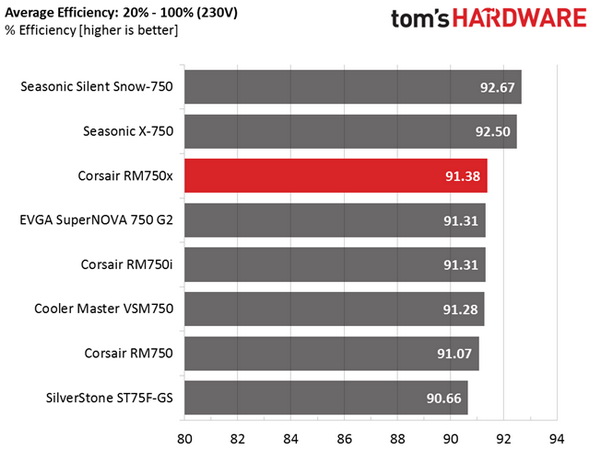

The RM750x that we had in hand proved to be a little more efficient, compared to the RM750i that we tested awhile ago. Compared to the competition, it scored very well; but it wasn't able to come even close to both Seasonic platforms with a similar capacity.
Efficiency At Low Loads
In the following tests, we measure the efficiency of the RM750x at loads significantly lower than 10 percent of the device's maximum capacity (the lowest load the 80 Plus standard measures). The loads we dialed were 20, 40, 60 and 80W. This is important for representing when a PC is idle, with power-saving features turned on.
| Test # | 12 V | 5 V | 3.3 V | 5 VSB | Power(DC/AC) | Efficiency | Fan Speed | Fan Noise | PF/AC Volts |
|---|---|---|---|---|---|---|---|---|---|
| 1 | 1.204A | 0.491A | 0.480A | 0.195A | 19.60W | 68.58% | 0 RPM | 0 dBA | 0.836 |
| 12.084V | 5.041V | 3.320V | 5.035V | 28.58W | 115.1V | ||||
| 2 | 2.437A | 0.989A | 0.992A | 0.395A | 39.70W | 79.16% | 0 RPM | 0 dBA | 0.929 |
| 12.079V | 5.040V | 3.318V | 5.030V | 50.15W | 115.1V | ||||
| 3 | 3.677A | 1.476A | 1.505A | 0.594A | 59.81W | 83.92% | 0 RPM | 0 dBA | 0.960 |
| 12.073V | 5.041V | 3.318V | 5.026V | 71.27W | 115.1V | ||||
| 4 | 4.902A | 1.985A | 1.988A | 0.795A | 79.75W | 85.82% | 0 RPM | 0 dBA | 0.969 |
| 12.068V | 5.042V | 3.316V | 5.023V | 92.93W | 115.1V |
Efficiency at light loads is very good. With 60W and 80W load, the RM750x easily passed the 80 percent mark, and even with 20W load it managed to stay close to 70 percent. Finally, on all of the above tests the unit's cooling fan wasn't engaged, although the ambient was close to 40 C.
5VSB Efficiency
The ATX specification states that 5VSB standby supply efficiency should be as high as possible, recommending 50 percent or higher efficiency with 100mA of load, 60 percent or higher with 250mA of load and 70 percent or higher with 1A or more of load.
We will take four measurements: one each at 100, 250 and 1000mA, and one with the full load the 5VSB rail can handle.
Get Tom's Hardware's best news and in-depth reviews, straight to your inbox.
| Test # | 5VSB | Power (DC/AC) | Efficiency | PF/AC Volts |
|---|---|---|---|---|
| 1 | 0.101A | 0.51W | 77.27% | 0.064 |
| 5.052V | 0.66W | 115.1V | ||
| 2 | 0.251A | 1.27W | 80.38% | 0.141 |
| 5.048V | 1.58W | 115.1V | ||
| 3 | 1.002A | 5.04W | 80.51% | 0.327 |
| 5.029V | 6.26W | 115.1V | ||
| 4 | 3.002A | 14.94W | 79.68% | 0.431 |
| 4.976V | 18.75W | 115.1V |
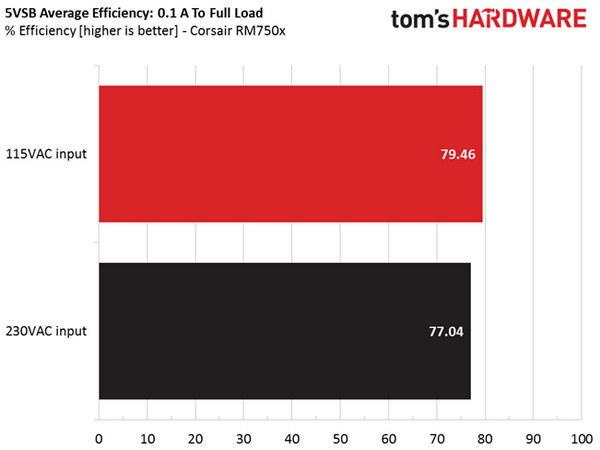
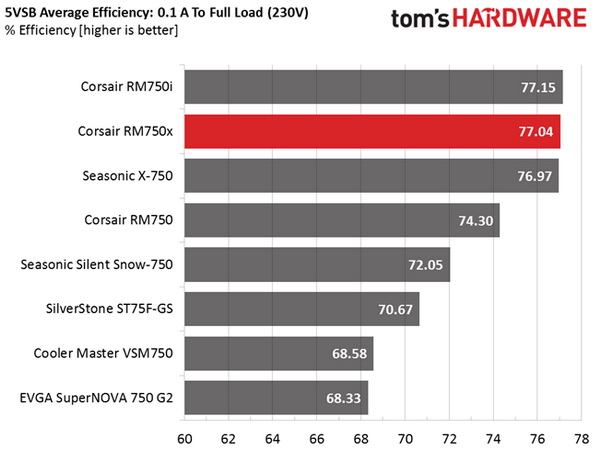
The 5VSB rail achieved very good efficiency levels. As you can see from the table above, it managed to score over 80 percent efficiency with 1A load — a result worth mentioning, since very few PSUs are able to pass the 80 percent mark in these tests.
Power Consumption In Idle And Standby
| Mode | 12 V | 5 V | 3.3 V | 5VSB | Power (AC) | PF/AC Volts |
|---|---|---|---|---|---|---|
| Idle | 12.091V | 5.043V | 3.323V | 5.043V | 8.34W | 0.470 |
| 115.1V | ||||||
| Standby | 0.05W | 0.005 | ||||
| 115.1V |
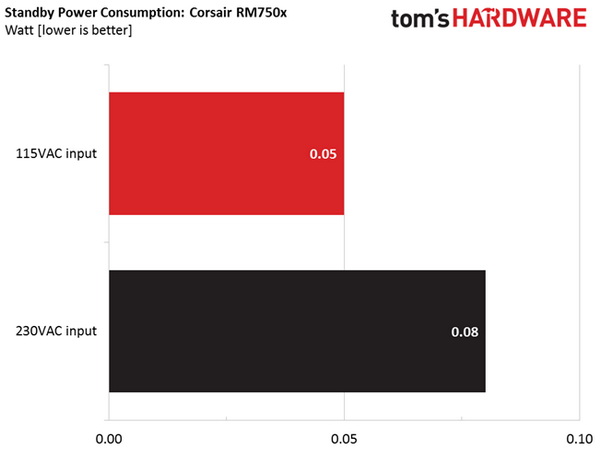
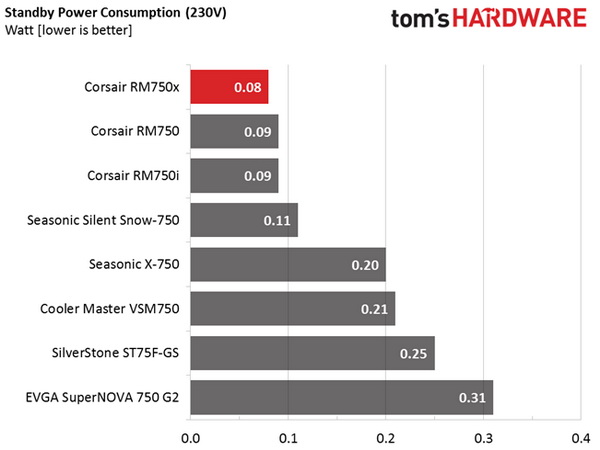
In the table above, you'll find the power consumption and voltage values of all rails (except -12V) when the PSU is idle (powered on, but without any load on its rails), and the power consumption when the PSU is in standby mode (without any load, at 5VSB).
Vampire power was extremely low with both 115V and 230V supply voltage. This plays a key role in the 5VSB rail's high efficiency levels, especially at light loads.
Fan RPM, Delta Temperature And Output Noise
Our mixed noise testing is described in detail here.
The first chart below illustrates the cooling fan's speed (RPMs), and the delta between input and output temperature. The results were obtained at 39 C (102.2 F) to 49 C (120.2 F) ambient temperature.
The next chart shows the cooling fan's speed (RPMs) and output noise. We measured acoustics from 1 meter away, inside a small, custom-made anechoic chamber with internals completely covered in soundproofing material (be quiet! Noise Absorber kit). Background noise inside the anechoic chamber was below 18 dB(A) during testing, and the results were obtained with the PSU operating at 39 C (102.2 F) to 49 C (120.2 F) ambient temperature.


The following graph illustrates the fan's output noise over the entire operating range of the PSU. The same conditions of the above graph apply to our measurements, though the ambient temperature was between 28 C (82.4 F) to 30 C (86 F).
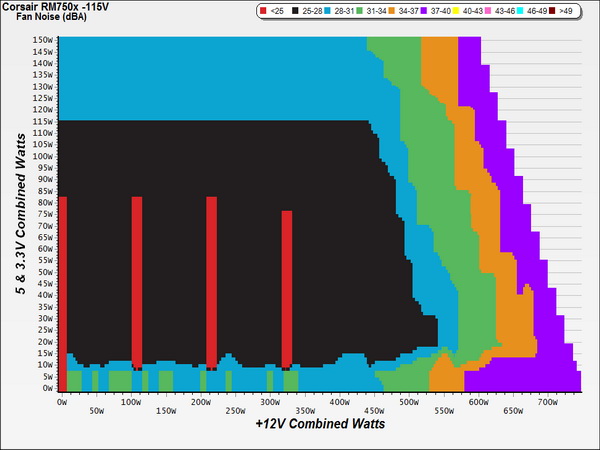
We believe that the high load that we applied from the start on the minor rails resulted in a very short passive mode. We noticed the same behavior in the RM750i, so most likely this is a quirk that is specific to this platform. Despite the short passive mode period during our cross-load tests, the PSU managed to operate very silently, overall.
Cross-Load Tests
Our cross-load tests are described in detail here.
To generate the following charts, we set our loaders to auto mode through our custom-made software before trying more than 1,500 possible load combinations with the +12V, 5V and 3.3V rails. The load regulation deviations in each of the charts below were calculated by taking the nominal values of the rails (12V, 5V and 3.3V) as point zero.
Load Regulation Charts

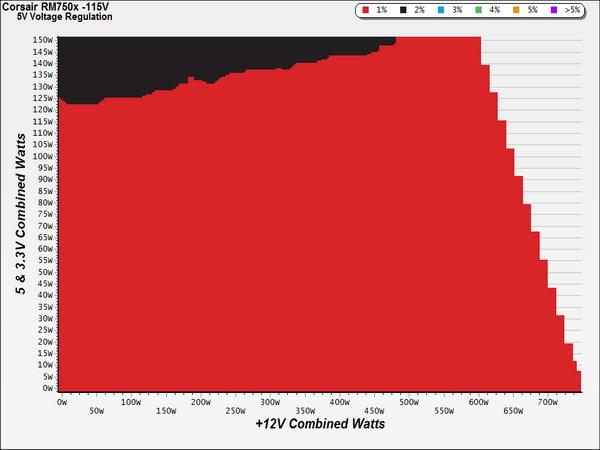

Efficiency Chart

Ripple Charts
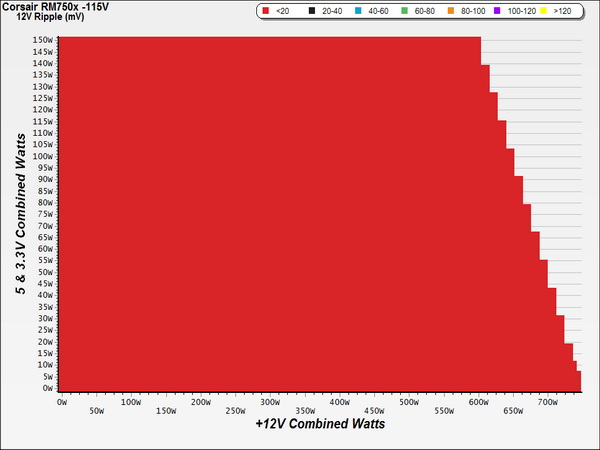

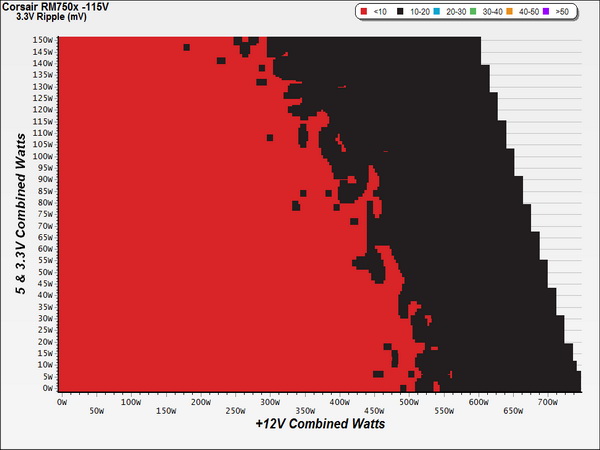

Infrared Images
Toward the end of the cross-load tests, we took some photos of the PSU with our modified FLIR E4 camera that delivers 320x240 IR resolution (76,800 pixels).

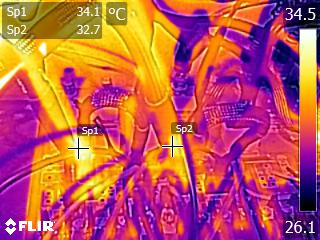
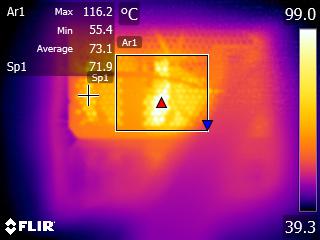
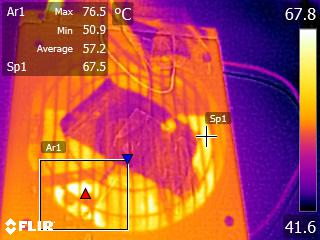



We pushed this PSU very hard, as you can see from the thermal shots above. In the worst-case scenario, the operating temperature of several components was well above 70 degrees Celsius (158 degrees Fahrenheit), and the very high temperature didn't seem to affect its performance in any notable way. During our overload test at 49.5 C (121 F) ambient temperature, the bridge rectifier went up to 116 C (240 F). However, that very high temperature didn't pose a problem for the proper operation of this specific component. On the contrary, the higher the working temperature of a bridge rectifier, the lower the voltage drops on its diodes are. Thus, efficiency is increased because less energy is wasted.
Current page: Efficiency, Temperature, Noise, Cross-Load Tests And Infrared Images
Prev Page Load Regulation, Hold-Up Time And Inrush Current Next Page Transient Response Tests And Ripple Measurements
Aris Mpitziopoulos is a contributing editor at Tom's Hardware, covering PSUs.
-
Blueberries I've been promoting these for a while, it's nice to see Tom's do an article on them. The only reason these are Gold rated is because they just miss the Platinum rating at 20%.Reply
They have a 650x as well that's a little cheaper. -
Amdlova High Rate Faliure can be the the name of this series of corsair. for Now EVGA or SEASONIC power supplies. don't spend a penny on corsair products...Reply -
Aris_Mp Please keep in mind that some Corsair PSUs are also made by Seasonic. Also this series is very new to have a high rate of failures. Unless you have some solid facts to share on the older RM line which is out for quite some time now.Reply -
jonnyguru Reply16801974 said:High Rate Faliure can be the the name of this series of corsair. for Now EVGA or SEASONIC power supplies. don't spend a penny on corsair products...
Wrong on so many levels.
YOU do not have the failure rate for this or any other Corsair PSU.
This PSU is the RMx, not the RM, so even if you did have a failure rate, it would only be about two weeks of data.
If you were talking about the RM and not the RMx, and you actually had failure rate data, you would see that the failure rate on the RM wasn't really high at all.
-
PureBlackFire ReplyHigh Rate Faliure can be the the name of this series of corsair. for Now EVGA or SEASONIC power supplies. don't spend a penny on corsair products...
*sigh* nonsense comment of the day.
-
chalabam Tomshardware:Reply
I don't know if this is a problem of your site, or my PC/IP, but frequently the charts do not load, even when the page "ends" loading.
Sometimes, if I "reload", then the charts also load.
I open all the article pages simultaneously, on different tabs, so I don't need to wait for each one to load. -
Rookie_MIB The older RM units weren't 'bad' really, they were ok, but Corsair has been stepping up its game with quality parts and build on some of these newer units which is nice to see. You can never have too many solidly designed units to choose from - competition toughens the breed.Reply -
Blueberries ReplyHigh Rate Faliure can be the the name of this series of corsair. for Now EVGA or SEASONIC power supplies. don't spend a penny on corsair products...
Did you even LOOK at the article? The only problem with these are the Sinopowers on the secondary side, and that's not even a "bad" thing. Oh and btw, some of the best power supplies in the world are Superflower OEMs produced by Corsair. -
mavikt With these in depth coverage of PSU's I propose introducing a tier'ing table thing at the and of each review (or perhaps a best buy PSU of the month) equivalent to what's done for CPU's and GPU's, ranking PSU models (perhaps too the makers). I saw a comment here on toms on another PSU news flash in the comment section referring to such thing in the forum but now I can't find it.Reply
Permanent'ing such thing from the editorial side would be great! -
Reply
High Rate Faliure can be the the name of this series of corsair. for Now EVGA or SEASONIC power supplies. don't spend a penny on corsair products...
Did you even LOOK at the article? The only problem with these are the Sinopowers on the secondary side, and that's not even a "bad" thing. Oh and btw, some of the best power supplies in the world are Superflower OEMs produced by Corsair.
Corsair doesn't use SuperFlower anywhere in its lineup. CWT, Great Wall, Flextronics, Seasonic and Chicony which has since been dropped are all the OEMs Corsair uses or has used.